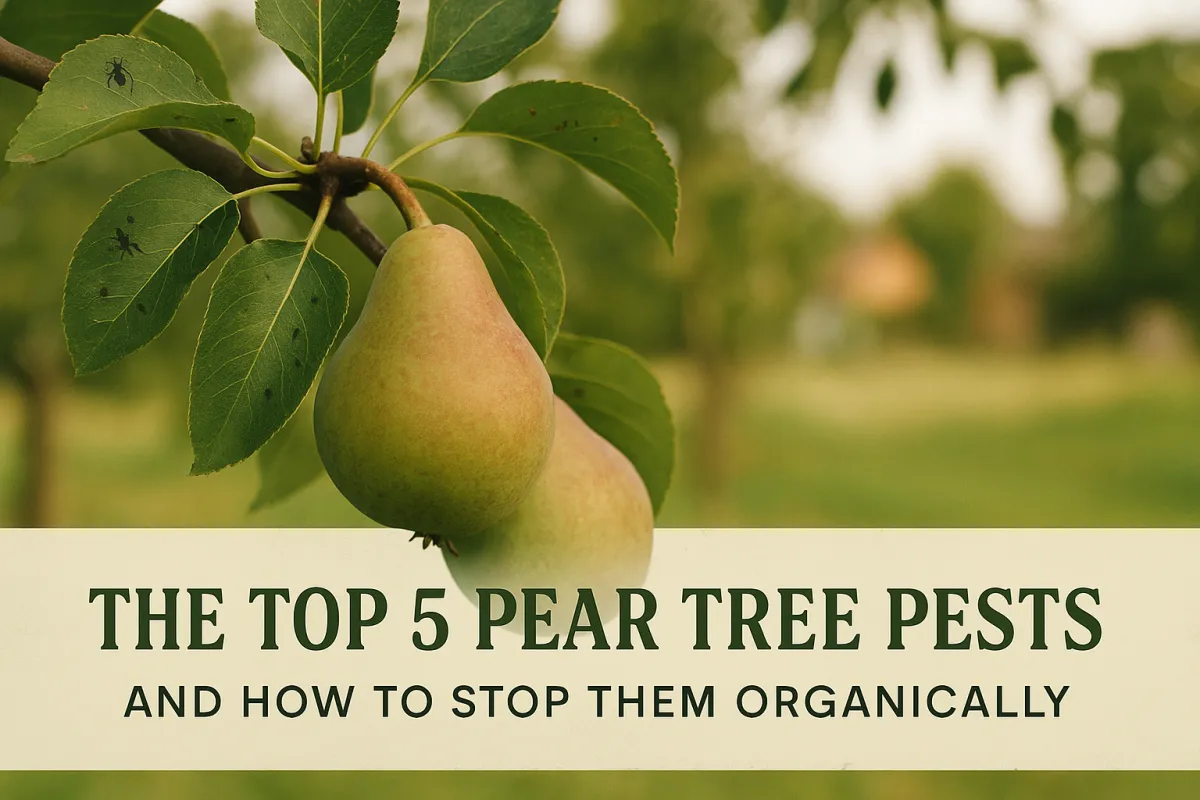
The Top 5 Pear Tree Pests (and How to Stop Them Organically)
A Hard Lesson from the Orchard
When I planted my first pear tree, I thought the biggest challenge would be waiting for it to bear fruit. I was wrong. By the second summer, I found sticky leaves, chewed bark, and pears riddled with holes before they ever ripened. I had done everything “by the book,” but I hadn’t accounted for the army of pests that wanted those pears more than I did.
If you want fruit that makes it from the tree to your table, you need to know what’s coming for your orchard. Pears are hardy trees, but they’re not invincible. Here are the top five pear tree pests I’ve faced—and how to beat them without turning to chemicals.
Region-Specific Note
Pear trees grow best in USDA Zones 4–9, though you’ll see differences in pest pressure depending on climate. In humid regions, pear psylla and aphids multiply faster. In drier climates, scale insects can get a foothold. No matter your zone, deer and rabbits will always find a way if you don’t protect young trees.
1. Pear Psylla: Tiny Bugs, Big Trouble
Pear psylla are sap-sucking insects that leave behind sticky honeydew, which quickly grows black with sooty mold. If your pear leaves look glossy and are curling, you’ve probably got psylla.
Step-by-step organic control:
Apply dormant oil spray in late winter before bud break. This smothers overwintering adults and eggs.
During the growing season, use neem oil or insecticidal soap when you first notice sticky residue.
Encourage natural predators like lady beetles and lacewings by avoiding broad-spectrum pesticides and planting nearby flowers that draw them in.
Grandma’s Tip: “If your tree looks like it’s sweating sugar, it’s not sweet—it’s sick.”
2. Codling Moths: Worms in the Fruit
You know the sight: a pear that looks perfect on the outside until you cut it open and find a worm tunneling through the flesh. That’s the codling moth at work.
Step-by-step organic control:
Pheromone traps in spring catch males and help you time sprays or treatments.
For small orchards, bagging fruit while it’s still young can prevent larvae from entering.
Pick up fallen fruit weekly. Moth larvae often pupate in rotting pears on the ground.
Pro Tip: Timing matters. Get those traps up before the first moths take flight, or you’ll always be chasing them after the damage is done.
3. Aphids: Sap-Suckers on New Growth
Aphids cluster on tender new shoots, turning healthy green leaves into curled, stunted growth. The sticky residue (honeydew) attracts ants, which protect aphids from predators.
Step-by-step organic control:
Blast them off with a hose. It won’t eliminate them, but it sets them back.
Release or encourage ladybugs and parasitic wasps, both natural aphid hunters.
If needed, apply neem oil or insecticidal soap on the undersides of leaves.
Grandma’s Tip: “Where the ants march, the aphids aren’t far behind.”
4. Scale Insects: Hidden Hitchhikers
Unlike aphids or psylla, scale insects don’t move around. They look like tiny bumps on bark and leaves. Left unchecked, they’ll suck a tree dry over time.
Step-by-step organic control:
If you only see a few, scrub them off with a soft brush.
Apply dormant oil spray in late winter to suffocate overwintering scale.
Beneficial insects—especially lady beetles and parasitic wasps—keep scale numbers down in summer.
Avoid This Mistake: Don’t spray oils once leaves are fully out and daytime temperatures rise. Oils can burn foliage if applied too late.
5. Deer and Rabbits: Bigger Pests with Bigger Appetites
Not all orchard pests are insects. Deer love tender pear shoots, while rabbits gnaw bark off young trunks in winter. I’ve lost more young trees to browsing than to bugs.
Step-by-step organic control:
Fencing: At least 8 feet tall for deer. For rabbits, use hardware cloth wrapped around trunks.
Tree guards protect young trunks from girdling.
Repellents (egg-based sprays, predator scents) work short-term, but rotate them or deer will adapt.
Pro Tip: A hungry deer doesn’t care about your spray. The only long-term solution is a physical barrier.
Faith Touch
Tending an orchard is more than pest control—it’s stewardship. Genesis 2:15 says, “The Lord God took the man and put him in the garden of Eden to tend and keep it.” Keeping pests in check is part of that calling. You’re not just protecting trees; you’re ensuring they can bear fruit in season, the way they were made to.
Closing: Keep the Orchard Ahead of the Pests
Pear psylla, codling moths, aphids, scale, deer, rabbits—they’re all manageable if you stay ahead of them. Organic sprays, beneficial insects, and physical barriers go a long way when used at the right time.
Don’t wait until the damage shows. Walk your orchard often, spot the signs early, and you’ll keep your pears clean, healthy, and headed for the kitchen table.
📥 Download the Pear Tree Pest ID & Treatment Checklist for quick reference during the season—it’s a tool I wish I’d had when I was starting out.
Encouragement: You can outsmart the pests if you work with nature, not against it.


Facebook
Instagram
X
Youtube